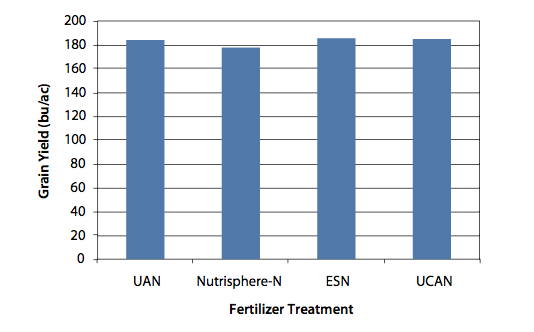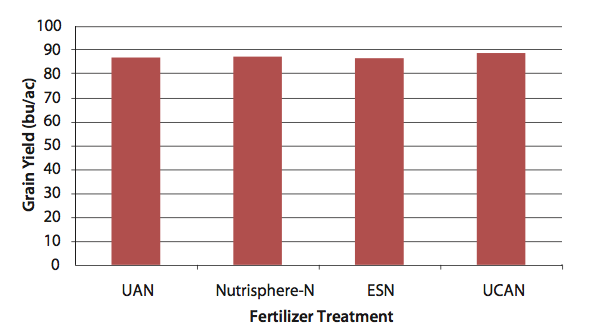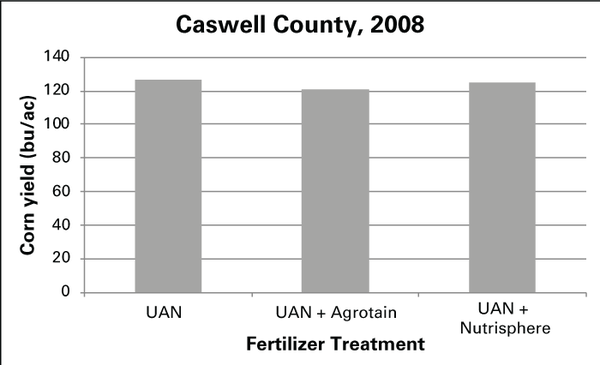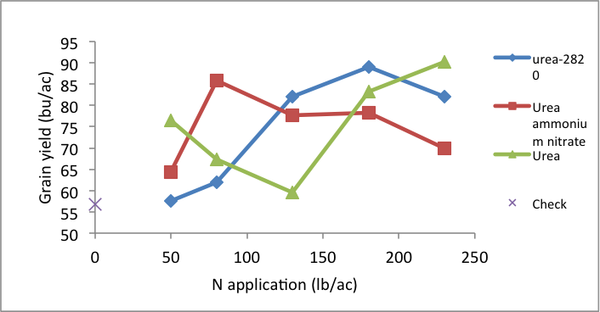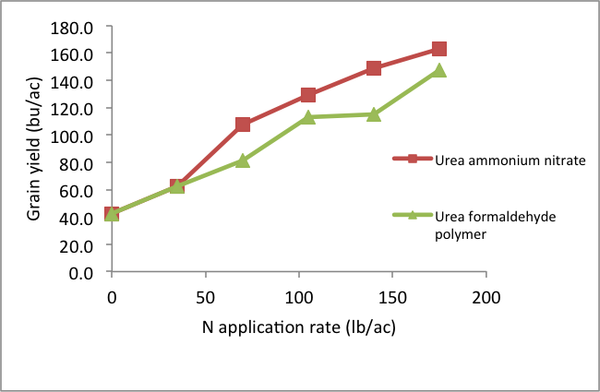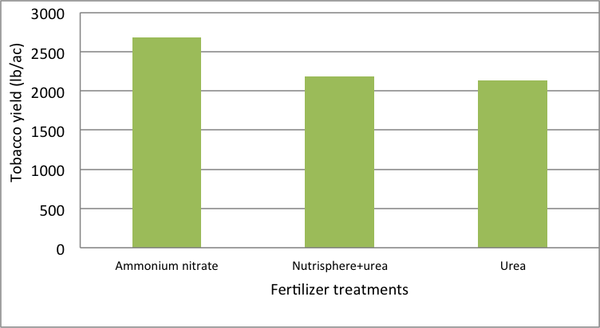Alternative nitrogen fertilizer products are being developed and marketed for their potential to increase yields and make nutrient use more efficient by decreasing losses of N through volatilization of gas ammonia or leaching of nitrate. How do these products actually perform on different soils and row crops under various climatic conditions? This publication summarizes findings from recent studies that investigated alternative nitrogen fertilizer products for row crops in four North Carolina regions.
What Alternative Nitrogen Fertilizer Products Are Being Marketed in North Carolina?
Nitrogen (N) fertilizers traditionally used in North Carolina are urea ammonium nitrate (UAN), urea, or a mix of the two. Their use is mostly due to availability, cost, and ease of transportation. Generally, about 50% of the N fertilizer applied to agronomic crops is used by the grain and stover of the crop. At application, N can be lost from urea-based fertilizers due to volatilization of ammonia gas; then N can be trapped in soil or leached as nitrate into water resources. Some controlled-release fertilizers, fertilizer enhancers, and other synthetic fertilizers are being marketed as potential solutions for low N use efficiency and to increase yields. It is not yet clear, however, that these products actually increase yield or N use efficiency.
The following fertilizers have been studied in North Carolina field trials.
- Ammonium nitrate is a granular fertilizer that contains 33% to 34% N.
- ESN® polymer-coated urea is a granular urea coated with a semipermeable polymer. It contains 44% N, and its N release is thought to be controlled by temperature and moisture.
- Urea contains 46% N and is granular. This is a traditional N source in North Carolina, mostly due to availability, cost, and ease of transportation.
- Urea ammonium nitrate (UAN) contains 28% to 32% N and is a water-soluble liquid. It is also a traditional N fertilizer in North Carolina.
- Urea formaldehyde polymer is a water-soluble liquid containing 30% N. The controlled-release N mechanism is microbially controlled.
- Urea-2820 is a urea treated with N-(n-butyl) thiophosphoric triamide (“NBPT”). It contains 46% N. The manufacturer claims it has the potential to reduce volatilization by slowing the urea transformation to ammonia.
- YaraLiva™ UCAN™-23 is a clear liquid N fertilizer plus calcium. It contains 23% total N and 4% calcium. It is designed to immediately supply available nitrate and ammonium and to gradually supply urea for continued feeding. The water-soluble calcium is thought to reduce ammonia volatilization from urea.
The following fertilizer additives have been studied in North Carolina field trials.
- AGROTAIN® is a commonly used urease inhibitor (NBPT). It is used with surface broadcast applications of urea or UAN. Higher yield from the use of this material might occur under conditions of high N volatilization potential.
- AGROTAIN PLUS® (NBPT+DCD-dicyandiamide) is another commonly used nitrogen inhibitor and contains urease and nitrification inhibitors, two materials that purportedly reduce ammonia volatilization and nitrate leaching.
- Instinct® II (microencapsolated nitrapyrin) slows nitrification from ammonium to nitrate.
- NutriSphere-N™ is a water-soluble fertilizer enhancer that the manufacturer claims creates an active shield around liquid fertilizers to protect N from volatilization and leaching. Because it is used in low quantities (typically 0.5% v/v), when mixed with UAN the solution contains similar percentage of N as the original UAN.
- NZone® is considered a “nitrogen management aid” and contains organic molecules and calcium. The manufacturer claims it alters the transformations of N in the soil, permitting its stabilization in the soil.
Alternative Nitrogen Fertilizer Field Trials in North Carolina
Corn and Wheat
A two-year corn and wheat field study (2008 to 2009) was conducted with NutriSphere-N, ESN, UCAN, and UAN at five to six different N rates on soils in the four regions of North Carolina (tidewater or lower coastal plain, coastal plain, piedmont, and mountains). Corn received all ESN and NutriSphere-N at planting (based on label recommendations), and UAN and UCAN were applied at approximately 30 lb N per acre at planting with the remainder at growth stages V4 to V6 (14 to 25 days after emergence). In three of the six site years, crops amended with NutriSphere-N and ESN had higher stover yields than UAN; in two of the six years, UCAN-treated crops produced higher stover yields than UAN fields (data not shown). However, there was no difference in corn grain yield associated with the four products (Cahill et al. 2010b), although there were differences between N rate (data not shown). Figure 1 shows yield results in the mountain region.
Wheat received 30 lb N ac-1 at planting and a second application in the spring. The second application of ESN and NutriSphere-N occurred in early February (based on label recommendations). The second UAN and UCAN treatments were applied to wheat in early March. The wheat grain yield data showed that the three alternative fertilizers performed similarly to UAN (Cahill et al. 2010b). Figure 2 shows yield results in the tidewater location. Wheat straw yields with ESN were consistently lower than with the other products. Examination of performance using different N rates did not indicate significant yield differences at any of the rates tested on either crop. Because the alternative N fertilizer products did not produce higher yields, the decision to use them in corn or wheat production would be heavily influenced by fertilizer pricing.
A one-year, on-farm corn trial with NutriSphere-N was conducted in Beaufort County (North Carolina tidewater) on a Portsmouth (mineral-organic) soil. Treatments were UAN and UAN plus NutriSphere-N, and rates were 0, 50, 100, 150, and 200 pounds of N per acre. As Figure 3 shows, corn yield increased as the N fertilizer rate increased, but the NutriSphere-N treatment did not significantly increase yields compared to UAN (Ambrose 2009).
Other corn yield studies in North Carolina have also indicated that alternative N fertilizers do not perform better than traditional N sources such as UAN and urea. For example, a 2008 corn study in the piedmont indicated that plots treated with UAN plus AGROTAIN or UAN plus NutriSphere-N did not yield higher than those treated with UAN only (Dycus 2009) (Figure 4). Finally, in a 2008 coastal plain corn study, plots were treated with 124 lb ac-1 of UAN or UAN plus NutriSphere-N with no yield differences observed (Dycus 2009) (Figure 5).
Winter wheat field trials were conducted from 2013 to 2015 in the coastal plain and piedmont to evaluate the effectiveness of ESN alone or blended with ammonium sulfate at different application times (Rajkovich et al. 2017b). Three treatments consisted of ESN or ESN blended with ammonium sulfate applied at growth stage 25 (Winter). One treatment consisted of a blend of 50% ESN and 50% ammonium sulfate applied at growth stage 30 (Spring). Two remaining treatments had all N supplied as UAN plus ammonium sulfate. One of these had all N applied at growth stage 30 (Spring-Traditional) and the second had half the N applied at growth stage 25 as ammonium sulfate and the remaining N applied at growth stage 30 as UAN (Split-Traditional). Compared to fertilizer applications without ESN, ESN treatments did not result in differing grain or straw yield in either region, or crop N uptake in the piedmont. There was a year by treatment interaction in the coastal plain, meaning that the treatments varied depending on the year. Grain yield was much lower during the 2013 to 2014 growing season compared to 2014 to 2015 (Table 1). Winter-applied ESN produced lower yields compared to spring applications during 2013 to 2014, but there were no clear differences between the ESN treatments and the non-ESN treatments in 2014 to 2015. ESN does not appear to provide yield increase for wheat production in North Carolina.
|
|
Grain Yield (bu ac-1) |
|||
|
Treatment |
2013–14 |
2014–15 |
||
|
Winter-ESN100% |
58 |
a |
123 |
c,d |
|
Winter-ESN75% |
61 |
a |
118 |
c |
|
Winter ESN50% |
63 |
a |
120 |
c,d |
|
Split-Traditional |
71 |
b |
125 |
c,d |
|
Spring-ESN50% |
71 |
b |
127 |
d |
|
Spring-Traditional |
78 |
b |
116 |
c |
A one-year field study was performed in the coastal plain, piedmont, and mountains of North Carolina to determine the effects of urea-2820 on corn yield and various plant parameters. When compared with urea and UAN, the urea-2820 did not consistently affect yield, earleaf tissue nitrate concentration, plant tissue color, plant height, grain and stover N concentrations, N uptake, or N use efficiency under the field conditions in those regions (Cahill 2010a, 2010b). Figure 6 shows coastal plain grain yields from the study. Based on these results, urea-2820 performs similarly to urea and UAN and does not offer an agronomic advantage.
In another corn and wheat study in North Carolina (2004 to 2006), crops were grown on sandy and mineral organic loamy soils. Treatments were urea formaldehyde polymer and UAN. There were six N rates for corn and five rates for wheat. Both N sources were band-applied as a split application for wheat: 30 lb N ac-1 at planting and a second application in the spring. Corn received two N fertilizer treatments: urea formaldehyde polymer at planting and a split application of UAN (30 lb N ac-1 at planting and a second application at stages V4 to V6), which is the current standard practice. For both crops and both sites, grain yield with UAN was statistically similar to or better than with urea formaldehyde polymer (Cahill et al. 2007) (Figure 7). Applying all urea formaldehyde polymer to corn at planting and split-applying to wheat did not significantly improve yield.
A two-year corn and wheat study (2013–2015) was conducted in which AGROTAIN PLUS, Instinct II, N-Zone, and UAN were used in three regions (coastal plain, piedmont, and mountains) at five to six different nitrogen rates. There was no significant difference between those products and UAN on corn grain yield (coastal plain and mountains) and wheat yield (coastal plain and piedmont), although there was an effect of N rate (Rajkovich et al. 2017a). In the piedmont, there was an interaction between year and product, indicating that the products can perform differently depending on yearly weather conditions. A lab incubation study with these same products demonstrated soils treated with UAN+nitrapyrin or UAN+NBPT+DCD delayed nitrification longer than soils treated with UAN or UAN+organo-Ca (data not shown); however, these products did not produce a difference in yield once we moved from the lab to the field.
Cotton and Tobacco
A two-year study (2007 to 2008) in the North Carolina piedmont compared yields of cotton when treated with 90 lb ac-1 of NutriSphere-N plus urea, urea plus AGROTAIN, UCAN, and urea. UCAN was not included in the 2007 study. The soil was a well-drained silt loam. In a two-year study, Braswell (2008) found that lint yields suggest there were differences between years, but N fertilizers performed similarly within each year (Figure 8). A 2008 burley tobacco yield study in the North Carolina piedmont compared NutriSphere-N, ammonium nitrate, and urea (Figure 9). The soil was a well-drained clay loam. We observed that yields were highest with ammonium nitrate. NutriSphere-N and urea produced similar yields (Fisher et al. 2008).
Summary
Alternative synthetic N fertilizers are often marketed as management tools for increasing crop yields and N use efficiency. The mechanisms of action for most of these alternative products inhibit or delay some step of the N transformations in the soil. Very often the effectiveness of these products is proved in laboratory conditions. However, when they are tested in field conditions, the products seldom promote increased yield. N transformations in the soil are complex, most of them driven by microorganisms and highly dependent on water and temperature conditions. Consequently, to be more effective than standard fertilizers, these alternative products need a perfect combination of soil type, time of application, temperature, moisture, and microbial activity. Various field studies across North Carolina and the South, on many different soil types, have shown that these alternative products rarely increase yields when compared to UAN or urea. For this reason, we recommend using the nitrogen fertilizer that best matches your production system and is most cost effective.
References
Ambrose, G. 2009. On-farm-test report—2009. Raleigh: North Carolina State University, NC Cooperative Extension, Beaufort County Center. (unpublished)
Braswell, S. 2008. Nitrogen efficiency enhancement studies. Raleigh: North Carolina State University, NC Cooperative Extension, Stanly County Center. (unpublished)
Cahill, S.L., D.L. Osmond, and D.W. Israel. 2010a. “Nitrogen Release from Coated Urea Fertilizers in Different Soils.” Communications in Soil Science and Plant Analysis 41, no. 10: 1–12.
Cahill, S.L., D.L. Osmond, R. Weisz, and R. Heiniger. 2010b. “Evaluation of Nutrient Efficiency and Yield in Corn and Wheat.” Agronomy Journal 102: 1226–1236.
Cahill, S., D. Osmond, C. Crozier, D. Israel, and R. Weisz. 2007. “Winter Wheat and Maize Response to Urea Ammonium Nitrate and a New Urea Formaldehyde Polymer Fertilizer.” Agronomy Journal 99: 1645–1653.
Dycus, D. 2009. Dec. Corn fertility test in Anson County, 2008–2009. Raleigh: North Carolina Department of Agriculture & Consumer Services, Agronomic Division. (unpublished)
Fisher, L., J. Priest, and S. Whitley. 2008. On-farm fertilizer study with NutriSphere-N on burley tobacco—2008. Raleigh: North Carolina State University.
Mitchell, C., and D. Osmond. 2012. New Technology and Alternative Nitrogen Sources for Crops in the Southern U.S. Southern Cooperative Series Bulletin No. 416-0. Auburn: Alabama Agricultural Experiment Station.
Nagy, S. 2008. NutriSphere-N and AGROTAIN Corn Trial—2008. Raleigh: NC State University, N.C. Cooperative Extension, Caldwell County Center. (unpublished)
Rajkovich, S.R., D.L. Osmond, R. Weisz, C. Crozier, and D. Israel. 2017a. “Evaluation of Nitrogen-Loss Prevention Amendments in Maize and Wheat in North Carolina.” Agronomy Journal 109, no. 5 (September): 1–14. doi.10.2134/agronj2016.03.0153.
Rajkovich, S., D. Osmond, R. Weisz, and C. Crozier. 2017b. “Evaluation of ESN for Use in Winter Wheat in North Carolina.” Crop, Forage and Turfgrass Management 1: 2014–0085. doi:10.2134/cftm2014.0085.
Acknowledgements
This publication is a revision of earlier versions. The authors would like to thank Sheri Cahill and Randy Weisz for their earlier contributions.
Publication date: July 27, 2020
AG-439-74
Recommendations for the use of agricultural chemicals are included in this publication as a convenience to the reader. The use of brand names and any mention or listing of commercial products or services in this publication does not imply endorsement by NC State University or N.C. A&T State University nor discrimination against similar products or services not mentioned. Individuals who use agricultural chemicals are responsible for ensuring that the intended use complies with current regulations and conforms to the product label. Be sure to obtain current information about usage regulations and examine a current product label before applying any chemical. For assistance, contact your local N.C. Cooperative Extension county center.
N.C. Cooperative Extension prohibits discrimination and harassment regardless of age, color, disability, family and marital status, gender identity, national origin, political beliefs, race, religion, sex (including pregnancy), sexual orientation and veteran status.

